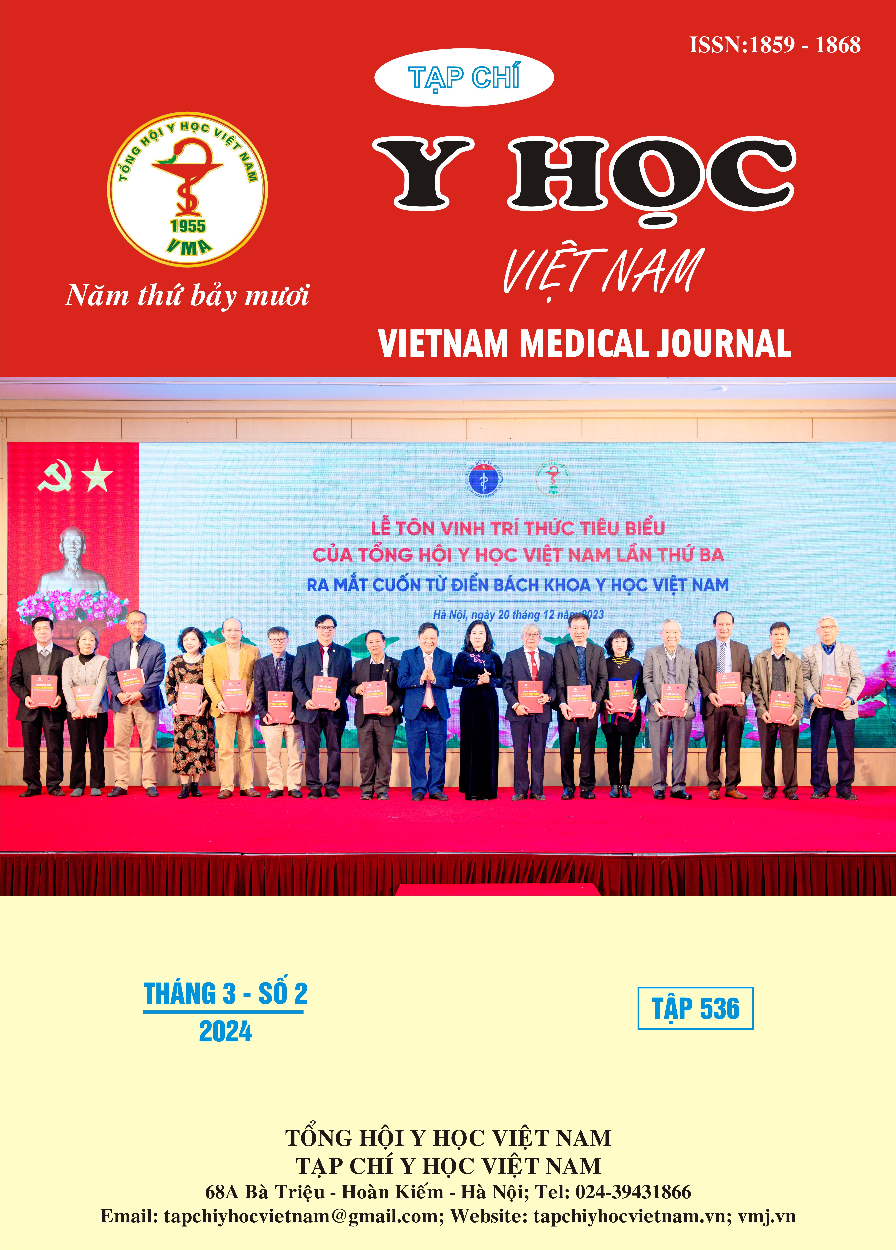RESULTS OF AORTIC VALVE REPLACEMENT SURGERY TO TREAT BICUSPID AORTIC VALVE DISEASE AT VIET – DUC UNIVERSITY HOSPITAL IN THE PERIOD 2018 - 2023
Main Article Content
Abstract
Overview: Bicuspid aortic valve is a common congenital heart disease. Gradually, the valve leaflets gradually degenerate, that make the stenosis and regurgitation of aortic valve, which leads to aortic valve disease, hence valve replacement surgery requirements. This study aims to evaluate the results of valve replacement surgery treating bicuspid aortic valve disease at Viet Duc University Hospital in the period from 2018 to 2023. Subjects and Methods: We were using data from SPSS 20.0 software, this is a descriptive study of retrospective cross-sectional with longitudinal follow-up study of patients diagnosed with bicuspid aortic valve disease who underwent valve replacement surgery, from January 2018 to January 2023, at Viet Duc University Hospital. Results: There were 58 patients with an average age of 59.9 ± 8.6 years (38 - 80), in which men accounted for 62.1%. NYHA heart failure classification at the moderate and severe levels is 100% (72.4% NYHA 2). Elevated transaortic valve pressure gradient on echocardiography - average 48.6 ± 19.0 mmHg (72% > 40 mmHg). During surgery, the average aortic clamp and cardiopulmonary bypass time were 77 minutes (35 - 135) and 98 minutes (55 - 157), respectively. After surgery, the average duration of mechanical ventilation was 17.5 ± 14.6 hours, of which the majority had their ectubation within 24 hours (86%). Common complications after surgery are pleural effusion (12%), surgical wound infection, pericardial effusion (1.7%), and acute kidney failure which does not require dialysis (5%). There was no intraoperative or postoperative mortality. Up to 2 years after surgery, 4 cases had died (6.8%), of which 3 cases were caused by cerebrovascular shock and 1 was endocarditis. Evaluating echocardiography at the time before surgery compared to when leaving the hospital and re-examination, the average index of pressure gradient across the aortic valve decreased with statistical significance (p < 0.05). Conclusion: Bicuspid aortic valve disease is quite common. Although the majority of patients are elderly, surgical treatment of aortic valve replacement gives early outcomes and medium-term results are relatively positive with a low rate of complications. However, the use of anticoagulants and underlying diseases are factors contributing to mid- and long-term fatal incidents.
Article Details
References
2. Lima B, Williams JB, Bhattacharya SD, et al. Individualized Thoracic Aortic Replacement for the Aortopathy of Bicuspid Aortic Valve Disease. J Heart Valve Dis. 2011;20(4):387-395.
3. Bonow RO, Carabello BA, et al. 2008 Focused Update Incorporated Into the ACC/AHA 2006 Guidelines for the Management of Patients With Valvular Heart Disease. Circulation. 2008;118(15): e523-e661. doi:10.1161/CIRCULATIONAHA.108.190748
4. Boodhwani M, de Kerchove L, Glineur D, et al. Repair of regurgitant bicuspid aortic valves: a systematic approach. J Thorac Cardiovasc Surg. 2010; 140(2): 276-284. e1. doi: 10.1016/ j.jtcvs. 2009. 11.058
5. Jasinski MJ, Kosiorowska K, Gocol R, et al. Bicuspid aortic valve repair: outcomes after 17 years of experience. Eur J Cardio-Thorac Surg Off J Eur Assoc Cardio-Thorac Surg. 2021;60(5): 1053-1061. doi: 10.1093/ejcts/ezab176
6. Svensson LG, Al Kindi AH, Vivacqua A, et al. Long-term durability of bicuspid aortic valve repair. Ann Thorac Surg. 2014;97(5):1539-1547; discussion 1548. doi:10.1016/ j.athoracsur. 2013.11.036
7. Ozaki S, Kawase I, Yamashita H, et al. Reconstruction of Bicuspid Aortic Valve With Autologous Pericardium. Circ J. 2014;78(5):1144-1151. doi:10.1253/circj.CJ-13-1335


